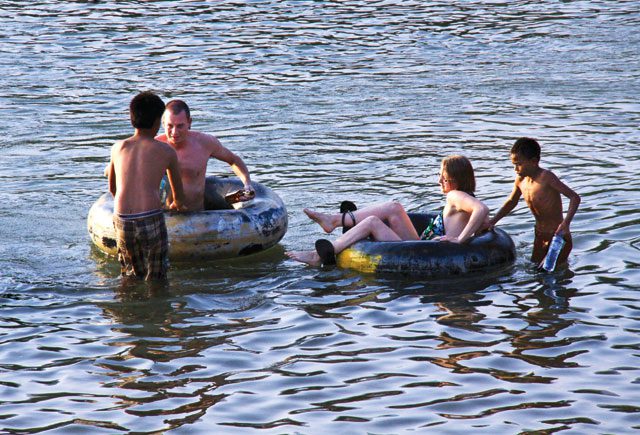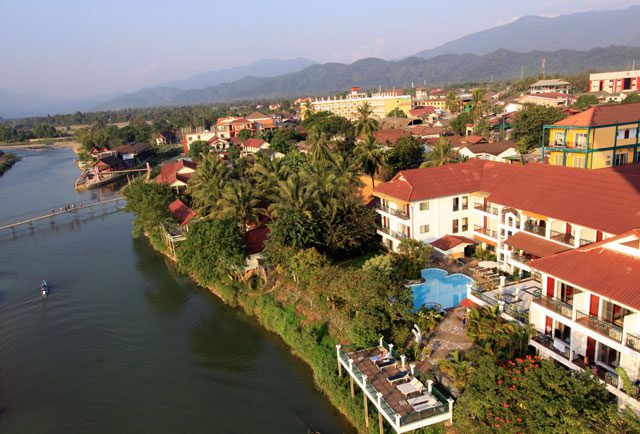The tubing party is over in Vang Vieng, but tourism has managed to stay afloat
By Manuel Meyer
The Nam Song River meanders slowly through Vang Vieng in Laos. A couple of kids are casting fishing lines into it, while women wearing straw hats are pushing rickety old bicycles across an old wooden bridge. They are returning from their day’s work in the surrounding rice paddies, while beyond the cliffs, a red sun is setting.

A handful of tourists are enjoying the moment, sipping gin and tonics with quiet chill-out music playing in the background as they take in their surrounds. But Emily, Jessica and Sophie, three students from Sydney, are deeply disappointed. “I don’t understand it,” Emily says. “It was here that things were really wild; a mega party. And now hardly anything’s going on.”
The three were in Vang Vieng two years ago. The scene was mainly Australian students, but also backpackers from the US and Europe, who came here during their semester break in order to be part of the “world’s wildest parties”, Jessica says.

Vang Vieng is located in the middle of the jungle landscape of northern Laos, about 180 kilometres north of the capital Vientiane. Nearly 120,000 partying youths used to descend on the provincial city every year.
One bar after another lined the streets, and party music blared out from countless discos day and night. Mojitos, whisky and Thai energy drinks were served up from plastic buckets. Cannabis, hallucinogenic mushrooms and opium pipes were available on every corner.
One highlight of the excessive partying in Vang Vieng was river tubing. Hundreds of drunk youths would go drifting down the river on the inflated inner tubes of lorry tyres. Every few metres along the banks of the four-kilometre river stretch hawkers would throw out a line and tow in one of the tubes with its cargo of inebriated tourists. The routine was always the same – after a free welcoming glass of schnapps, hard drinks in ten-litre buckets were waiting. Ready-rolled joints and other drugs were openly on sale at the bar.
After several hours, the party-goers returned like zombies to the water. But not everybody made it that far. Many would drunkenly slip on the rocks, breaking their bones. Others were injured while tubing or suffered from alcohol poisoning.
“Every day we used to treat at least a dozen tourists for cuts and broken bones,” a doctor at a local hospital recalls.
In 2011 there were nearly 30 deaths, prompting the provincial government to play the role of party-pooper. An army of police descended on Vang Vieng last year, closing down dozens of illegal bars and discos, and enforcing rules that tourists could only go tubing with a life jacket on and without alcohol.
“We used to be open almost 24 hours daily. Now we have to shut down at 1am and the music has to be turned down at midnight,” the Jungle Bar’s Mr Kee says bitterly, his eyes scanning an empty establishment. He estimates that tourism has plunged 70% since the government stepped in. “The people want to party. Now they’ll go looking for another place.”
This doesn’t bother Vone, a 36-year-old tour operator who admits that clientele numbers have dwindled. “But honestly speaking, I’m happy that it’s over,” he says. “First, it was much too dangerous and, secondly, it was neither good for us nor for our children.
“All they [the children] saw the whole day through was drunken youths and half-naked girls in bikinis, wildly making out everywhere you looked,” he says. “We Laotians are a very quiet, reserved and conservative people. The two things didn’t fit together.”
Up until last year, Vone had lived primarily from tubing rentals. Now he is concentrating on organising hikes, rafting, cycling and climbing tours in the surrounding mountains. This is Vang Vieng’s new tourism strategy, and it seems to be working.
By bicycle, one route leads through rice fields and small farming villages to the cave of Tham Poukham, seven kilometres away. Entry is free, but visitors enter at their own risk with flashlights to navigate the labyrinth of passageways, some of them still unchartered. In the middle of the first main cavern there is a statue of Buddha, illuminated by the sun’s rays, let in by a huge hole in the ceiling.
“This is crazy. It’s pure adventure,” says Steffen Kasber, a 25-year-old German tourist. “I’ll bet that all those party fans in the past had no idea what they were missing.”
Also view:
“A pocket of resilience” – From the Ho Chi Minh Trail to the edge of the tourist trail in northern Laos
“Playing dirty” – Everyday Laotians are finding that joining the Asian Century comes with hidden costs
“Suck it up” – Chi Phat is no walk in the park, but visitors prepared to rough it will be rewarded with an unforgettable travel experience

